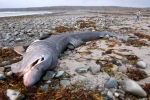Dead basking shark found on beach in Canada
Dead basking shark found on beach in Canada. Reported on 23. January 2012. Shelburne County, Nova Scotia, Canada. The specimen washed up near Locke’s Island at the head of Jordan Bay last week.
Influence of intra-specific predator-prey interactions on juvenile lemon sharks
Published online on 20. January 2012. Deep danger: intra-specific predation risk influences habitat use and aggregation formation of juvenile lemon sharks Negaprion brevirostris Tristan L. Guttridge, Samuel H. Gruber, Bryan R. Franks, Steven T. Kessel, Katie S. Gledhill, Jen Uphill, Jens Krause, David W. Sims ABSTRACT: Non-consumptive or risk effects imposed by predators can influence
Effects of an extreme temperature event on bull sharks
Not published yet Effects of an extreme temperature event on the behavior and age structure of an estuarine top predator, Carcharhinus leucas Philip Matich, Michael R. Heithaus ABSTRACT: The frequency of extreme environmental events is predicted to increase in the future. Understanding the short- and long-term impacts of these extreme events on large-bodied predators will
Mercury in deepwater chondrichthyans off southeastern Australia
Not published yet. Trophic structure and biomagnification of mercury in an assemblage of deepwater chondrichthyans collected off southeastern Australia H. Pethybridge, E. C. V. Butler, D. Cossa, R. Daley, A. Boudou ABSTRACT: Stable isotope ratios of carbon (δ13C) and nitrogen (δ15N) were used to evaluate trophic structure and mercury biomagnification in an assemblage of 16
Living with high concentrations of urea: They can!
Published in Jan 2012 Francesca Trischitta, Caterina Faggio, Agata Torre ABSTRACT: Marine elasmobranchs maintain their body fluid isoosmotic or slightly hyperosmotic to the external medium by the retention of large urea concentrations. This review focuses on the strategies adopted by these fishes to maintain a large outwardly direct concentration gradient of this osmolyte minimizing the




